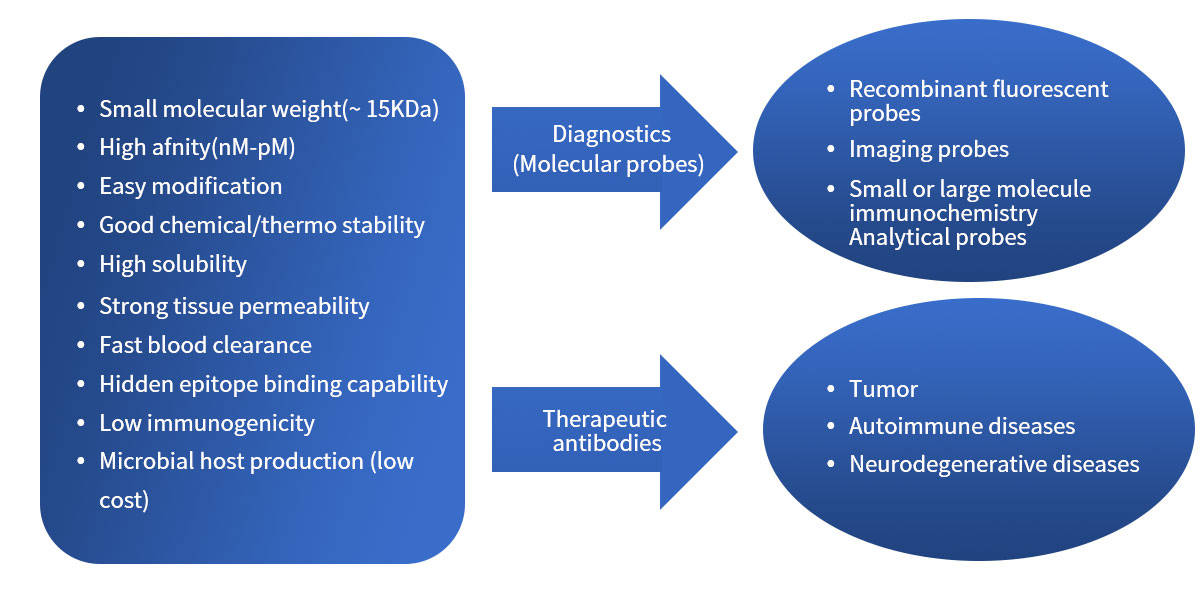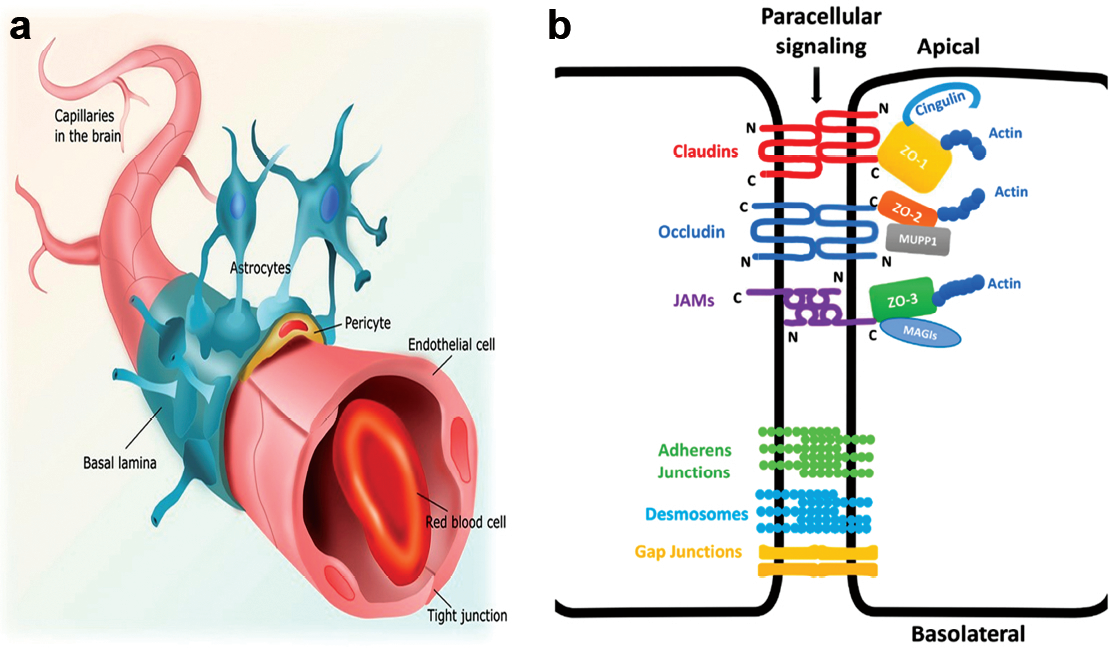Research Field
Nanobody Technology
In 1993, Belgian scientist Hamers found a kind of called heavy chain ABS (hcabs) lacking light chain and ch1 constant region in camels, cloned its variable region, and obtained the variable domain of the heavy chain of heavy chain antibody (VHH), namely nanobody. In addition, similar heavy chain antibodies have also been found in some cartilaginous fish such as sharks.
Single domain antibodies (nanobodies) have many unique advantages in diagnosis and disease treatment due to their small molecular weight, high affinity, easy transformation, good stability and other characteristics. They are favored by the academic and industrial circles in the biological field. With the launch of the first nanobody drug and the disclosure of many other single domain antibodies (nanobodies) based biologics pipelines, the development of single domain antibodies (nanobodies) biologics has become a hot spot.
RegeneCore is committed to innovative biopharmaceutical development of nanobody technology. At present, a number of R&D pipelines involving autoimmune diseases, tumor treatment, etc. have been laid out. At the same time, ADC technology and cell therapy products based on single domain antibodies (nanobodies) have also been developed.

Nanobody drugs
Nanobodies have the characteristics of strong stability and small molecular weight, which can reduce the immunogenic risk of drugs, and the mode of administration is more flexible.
At present, there are about 20 kinds of nanobody drugs in different stages of clinical trials in the world. The diseases treated include soft tissue sarcoma, biliary tract cancer, multiple myeloma, non-small cell lung cancer, B-cell lymphoma and other tumors, as well as autoimmune diseases such as rheumatoid arthritis, systemic lupus erythematosus, psoriasis, diarrhea and respiratory syncytial virus infection caused by viruses.
Precise delivery based on nanobody
Nanobodies are small in size and tend to bind to concave epitopes (such as the catalytic site of enzymes). Therefore, nanobodies have stronger tissue penetration ability, and can recognize grooves, seams or hidden antigen epitopes on the target surface that are difficult for conventional antibodies to access. They can enter dense solid tumor tissues to play a role, and even effectively penetrate the blood-brain barrier. At the same time, the tiny size of the nanobody does not hinder the binding affinity, and it shows antigen binding force comparable to that of monoclonal antibody. Compared with monoclonal antibodies, nanobodies have superior tumor targeting and stability, which can realize targeted delivery of drugs and thus achieve precise treatment.
Nanobody diagnostic reagent
The advantages of nanobody also make it popular in the diagnostic reagent industry and scientific research field.
VHHs have high thermal stability (high refolding capacity) and relative resistance to harsh environments, such as gastrointestinal and chemical degeneration, non physiological pH and high pressure. These characteristics make VHHs ideal reagents for oral and nebulization therapy, antibody drug coupling and immobilization on microchip biosensors.
At present, VHHs are being developed for infectious diseases (sars-cov-2), cancer (bispecific antibodies and CAR-T), central nervous system diseases (BBB drug delivery), and other fields. In the next decade, more therapeutic and diagnostic reagents based on VHH will enter the market, hoping that they will be cheaper and have superior or at least complementary drug functional activities than traditional mAbs and their fragments.
2. Field of Neurobiology
Neurobiology is one of the frontier disciplines of life science recognized by the scientific community today. Neurobiology involves anatomy, physiology, pharmacology, pathology, biochemistry, cell biology, molecular biology and other related disciplines. Its task is to study the cellular, molecular and intercellular change processes in the nervous system, as well as the integration of these processes in the central functional control system, up to complex advanced functions such as learning and memory.
The nervous system plays a key role in development and oncology, regulating stem and precursor cell populations in tissues and affecting cancer cell growth and metastasis. In recent years, more and more studies have shown that the nervous system plays a key role in the initiation and metastasis of cancer. In depth research and exploration of neurobiology is of great significance for the treatment of malignant diseases, major brain diseases and the development of new artificial intelligence technologies.

a. Structure of the capillaries of the neurovascular unit.
b. Schematic representation of inter endothelial junctions composed of tight junctions, adherens junctions, and gap junctions.
Parkinson's treatment
Parkinson's disease (PD) is a common degenerative disease of the nervous system. Its characteristic pathological changes are the progressive degeneration of dopaminergic neurons in the substantia nigra and the formation of Lewy bodies. With the continuous reduction of dopamine transmitter in the striatum and the imbalance of dopamine and acetylcholine transmitters, the clinical symptoms of patients are increasing, mainly manifested as tremor, myotonia, bradykinesia Motor symptoms such as postural balance disorders, and non motor symptoms such as sleep disorders, olfactory disorders, autonomic dysfunction, cognitive and mental disorders.
Epidemiological survey results show that the prevalence of Parkinson's disease in people over 65 years old in China is 1.7%, which is at the world average level. With the increasing aging society, the number of patients with Parkinson's disease in China will rise to 5million in 2030.
Alzheimer's treatment
Alzheimer's disease (AD) is a neurodegenerative disease with insidious onset and progressive development. Its clinical characteristics are mainly cognitive impairment, abnormal mental behavior and functional decline in social life. Its pathogenesis has not yet been fully elucidated. With the development of the aging process of the global population, the number of AD patients continues to rise. According to WTO statistics, there were about 29.8 million people with ad in the world in 2015. It is estimated that there will be about 66million AD patients in the world by 2030 and 115million by 2050.
The global investment in AD treatment has increased significantly year by year. According to the data of the American Association for drug production and research and development, the world has invested more than 600billion dollars in Alzheimer's disease research and development, and more than 300 kinds of clinical drugs have failed. Although the failure rate of AD drug research and development exceeds 99%, drug companies have not given up the development of ad drugs.
Autism treatment
Autism disorder, also known as autism spectrum disorder (ASD), is one of the most common subtypes of pervasive developmental disorders in childhood. Its core clinical manifestations are social interaction, language communication disorders, cognitive deficits and repetitive stereotypies.
In 2021, centers for Disease Control and Prevention (CDC) showed that the prevalence of ASD increased from 1:68 in 2014 to 1:44.
The pathogenesis of autism is related to genetic factors, non genetic factors and the complex interaction between them. Among them, synaptic protein gene mutation, chromosome variation, molecular pathway dysfunction and brain inflammatory reaction are the main factors that lead to the occurrence of autism. There are differences in the manifestations of this disease in different individuals and ages, and there is no clear pathogenesis and accurate and unified treatment. The development of ASD prevention and treatment drugs still has a long way to go, but with the more and more in-depth research on the treatment targets of ASD core symptoms, it is believed that the research and development in this field has good scientific research potential and development prospects.
TEL:
Address: Room 07 Building 16 Treehouse, No. 73, Tanmi Road, Jiangbei New District, Nanjing
Enterprise email:rjk@regenecore.com

WeChat cooperative consultation
You are the th visitor

 025-58608860
025-58608860 

 Contact
Contact 